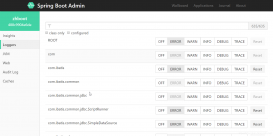最近陆续用python写了很多文件处理脚本,虽然功能都比较简单 ,但还是感觉到python对文件处理的简洁高效 ,越发觉得java的语法相当的繁琐~
接到个需求处理ftp数据接口 。所以想把python脚本也用上。java代码定时扫描ftp数据仓库 ,调用python脚本入库。
直接采用java执行系统命令的方式
|
1
2
3
4
5
6
7
8
9
10
11
12
13
14
15
16
17
18
19
20
21
22
23
24
25
26
27
28
29
30
31
32
33
34
35
36
|
@async public void readfilebypython(list<string> filepaths) throws filenotfoundexception { url localsrcurl = abstractreadfileline.class.getresource(""); string localsrcpath = localsrcurl.getpath(); localsrcpath = localsrcpath.substring(1, localsrcpath.length()); string pythonfile = localsrcpath + "pythonfilehandle.py"; int size = filepaths.size() + 2; string[] args = new string[size]; args[0] = "python"; args[1] = pythonfile; for(int i =0;i<filepaths.size() ;i++){ int index = i+2; args[index] = filepaths.get(i); } try { system.out.println("start"); process proc = runtime.getruntime().exec(args); inputstream is = proc.geterrorstream(); inputstreamreader isr = new inputstreamreader(is); bufferedreader br = new bufferedreader(isr); string line = null; system.out.println("<error>"); while((line = br.readline())!=null){ system.out.println(line); system.out.println("</error>"); int exitvalue = proc.waitfor(); system.out.println("process exitvalue="+exitvalue); } system.out.println("end"); } catch (exception e){ e.printstacktrace(); } } |
string[] args = new string[size];
args[0] = "python"; args[1] = pythonfile; args[0]表示要执行的是python 脚本 ,args[1] 脚本文件的全路径
该方法调用 abstractreadfileline.class 文件路径下的 pythonfilehandle.py 脚本 ,并传入string数组类型的参数(需要处理的文件全路径)
pythonfilehandle脚本接受java传入的文件路径参数(数组),解析并入库
pythonfilehandle.py 代码
|
1
2
3
4
5
6
7
8
9
10
11
12
13
14
15
16
17
18
19
20
21
22
23
24
25
26
27
28
29
30
31
32
33
34
35
36
37
38
39
40
41
42
43
44
45
46
47
48
49
50
51
52
53
|
import pymssql,time,sysreload(sys)sys.setdefaultencoding("utf-8")class mssql: def __init__(self,host,user,pwd,db): self.host = host self.user = user self.pwd = pwd self.db = db def __getconnect(self): if not self.db: raise(nameerror,"") self.conn = pymssql.connect(host=self.host,user=self.user,password=self.pwd,database=self.db,charset="utf8") cur = self.conn.cursor() if not cur: raise(nameerror,"") else: return cur def execquery(self,sql): cur = self.__getconnect() cur.execute(sql) reslist = cur.fetchall() # self.conn.close() return reslist def execnonquery(self,sql): cur = self.__getconnect() cur.execute(sql) self.conn.commit() self.conn.close() def inserttocloselist(data ,ms): sql = "insert into t_isee_closelist_infos (work_order_id,crm_cdsc_id,appraise_type,crm_accept_date,latn_code,theme_row_id,task_execute_row_id,crm_accept_reason,asset_integ_id) values ( '" temp ="' , '" sqlstr = temp.join(data) sql = sql + sqlstr + "')" ms.execnonquery(sql) ms = mssql(host="172.30.0.186",user="sa",pwd="",db="test")fengefu = '$%$'for i in range(1, len(sys.argv)): read = open(sys.argv[i] ,'r') for line in read: line=line.strip('\n') data = line.split(fengefu) inserttocloselist(data,ms) read.close |
sys.argv[0] 存储的是py文件自身的路径,故接受参数从sys.argv[1]开始。
以上所述是小编给大家介绍的java调用python脚本传递参数详解整合,希望对大家有所帮助,如果大家有任何疑问请给我留言,小编会及时回复大家的。在此也非常感谢大家对服务器之家网站的支持!

















